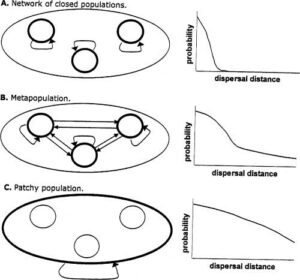Back to: Botany 500 Level
My Afrilearn correct person!
How your body dey today? I dey always happy anytime you show face, because I know say you dey ready to collect another portion of knowledge wey go help you shine like first star for night sky. Today, our lesson na one wey go help you reason how plant populations behave, how dem spread, and how dem dey structured. Just relax as I break am down like sweet Naija story.
Population dynamics, dispersion, and structure
First, make we understand this thing wey we dey call population dynamics.
You know say for any community—whether na plants, animals or even people—things no dey always stay the same. People dey born, some go travel, others go kpai (die), and new people go enter. Na the same thing dey happen with plants. Population dynamics na how the number of individuals in a plant population dey change over time.

For example, if one farmer plant 100 maize seeds today, some go germinate, some go die early, some go grow and produce seeds. Then next season, those seeds go germinate and increase the number of maize for that area. This movement—of births, deaths, migrations—na wetin dey form population dynamics.
Four main things dey influence population dynamics:
- Birth rate (plants producing seeds or new shoots)
- Death rate (plants dying from diseases, herbivores or harsh weather)
- Immigration (new plants entering the area, maybe by wind or birds carrying seeds)
- Emigration (plants being removed or dying off and not replaced)
Now, make we talk about population dispersion.
This one mean how the plants dey spread for space—whether dem dey together like tight choir group, or spread like crowd for market. E get three main types:
- Uniform Dispersion – when plants dey evenly spaced. This fit happen when each plant dey compete for resources, like in oil palm plantations. Farmers plant them with enough space so dem no go fight for nutrients or light.
- Clumped Dispersion – this na the most common. Plants dey grow in groups where the environment dey favour dem. For example, mushrooms wey dey grow under moist logs, or coconut trees wey dey gather near water.
- Random Dispersion – this one na when plants no get fixed pattern. E dey happen when seeds just dey fall and germinate anyhow without control. You fit see am with weeds after heavy rain.
Last one na population structure.
This one talk about the make-up of the population. E dey look age, size, or even height of plants within the group. For example, inside one mango plantation, you fit get small-small seedlings, medium young trees and big old mango trees—all these represent different age groups. The way these age groups dey arranged go affect how the whole population grow.

If most of the plants dey young, the population go increase fast. But if most of dem old and near death, the population fit reduce unless new ones enter.
Summary:
- Population dynamics study how plant populations grow, shrink or stay the same over time.
- Dispersion na how plants spread: uniform, clumped or random.
- Population structure look into the age, size, and arrangement of plants within a population.
Understanding these things help scientists, farmers and planners manage crops, forests and green spaces better.
Evaluation:
- What are the four main factors that affect population dynamics?
- Describe one type of population dispersion with a Nigerian example.
- How does population structure affect plant population growth?
You dey reason like Professor already, I swear! Na so learning suppose be—sweet, clear, and useful! As you dey master all these Botany lessons, just dey picture how you go use am make change for your community and the world. With Afrilearn, you dey on top path! Until next lesson, keep your brain sharp and your confidence high. You too much!
